The Archdiocese of Hartford comprises the counties of Hartford, Litchfield and New Haven in Connecticut.
Hartford was established as a diocese on November 28, 1843 and created as an archdiocese on August 6, 1953. It includes the following towns and cities:
Ansonia, Avon, Bantam, Barkhamsted, Beacon Falls, Berlin, Bethany, Bethlehem, Bloomfield, Branford, Bridgewater, Bristol, Broad Brook, Canaan, Canton, Cheshire, Colebrook, Collinsville, Cornwall, Cornwall Bridge, Derby, Devon, East Berlin, East Granby, East Hartford, East Hartland, East Haven, East Windsor, Elmwood, Enfield, Farmington, Forestville, Glastonbury, Goshen, Granby, Guilford, Hamden, Hartford, Hartland, Harwinton, Kensington, Kent, Lakeville, Litchfield, Madison, Manchester, Marlborough, Meriden, Middlebury, Milford, Mount Carmel, Naugatuck, New Britain, New Hartford, New Haven, New Milford, New Preston, Newington, Norfolk, North Branford, North Canaan, North Haven, Northfield, Northford, Oakville, Orange, Oxford, Plainville, Plantsville, Pleasant Valley, Plymouth, Poquonock, Prospect, Rocky Hill, Roxbury, Salisbury, Seymour, Sharon, Simsbury, South Glastonbury, South Meriden, South Windsor, Southbury, Southington, Suffield, Tariffville, Terryville, Thomaston, Torrington, Union City, Unionville, Wallingford, Warren, Washington Depot, Waterbury, Watertown, West Hartford, West Haven, West Simsbury, Wethersfield, Winchester, Windsor, Windsor Locks, Winsted, Wolcott, Woodbridge, Woodbury, Woodmont, Yalesville.
The Coat of Arms of the Archdiocese of Hartford
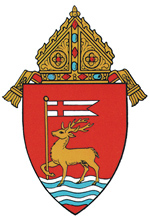
The arms of the Archdiocese of Hartford are called canting arms or armes parlantes, which speak or proclaim the name of the bearer. It displays a hart (deer) crossing a ford (hart+ford = Hartford), and is analogue to the ancient arms of the City of Oxford in England which displays an ox crossing a ford in the same manner. The hart bears a Paschal banner, a symbol of Jesus Christ. The wavy silver and blue lines at the base of the shield are the heraldic convention for water and are an allusion to the Connecticut River which flows through the state. These arms were designed by Pierre de Chaignon Larose and have been used since Bishop John J. Nilan’s term as seventh Ordinary of the See, 1910-1934.
Historical Highlights of the Archdiocese of Hartford
The Diocese of Hartford is deeply rooted in the faith of our early Catholic ancestors who settled in Connecticut. It was with a desire to extend greater service that Bishop Fenwick of Boston petitioned the Holy See for a division of his diocese which led to the establishment of the diocese of Hartford. Today, with great respect and pride, we recall the efforts of those dedicated men and women who left us a rich heritage which we call the Church of Hartford.
In his work entitled, The Catholic Church in Connecticut, Thomas Duggan states that, “The Catholic Church has been represented in Connecticut from the days of its earliest white settlers.” From colonial times until the arrival of the first resident in 1651, the Catholic Church in Connecticut lived very much in the shadows of the deeply Congregational tradition. The missionary zeal of those early priests led to the establishment in Hartford of the Church of the Holy Trinity which was dedicated by Bishop Fenwick on May 8, 1834. Nine years later in the spring of 1843, Bishop Fenwick, who was advanced in age, recommended to the Fifth Provincial Council of Baltimore that greater concern be given to the care of the Catholic souls in Connecticut. Bishop Fenwick proposed that his Boston diocese be divided so that a separate diocese could be established encompassing the States of Connecticut and Rhode Island.

On November 28, 1843, Pope Gregory XVI issued a Papal Bull establishing the See of Hartford with Reverend William Tyler, Vicar General of Boston and a convert to Catholicism, as its founding bishop. The primary responsibility of the young bishop would be the pastoral care of the 10,000 Catholics who comprised the diocese. Believing that the bishop should be nearer to the greater number of Catholics, in 1844, Bishop Tyler petitioned Rome to move the See of Hartford to Providence, Rhode Island. A man of great humility, Bishop Tyler struggled to reduce the large debt, and with missionary zeal, spent his life in service of his new flock. Bishop Tyler died in 1849, at the early age of 45 after serving as a bishop for five years.

Hartford’s second bishop, the Right Reverend Bernard O’Reilly worked untiringly to secure young priests for the diocese. While remaining in Providence, he sought to shield his flock from the anti-Catholic movements of the era, such as the Know-Nothing Party that was striving to destroy the Catholic Church in America. Bishop O’Reilly was lost at sea on the ill-fated steamer, Pacific, in January 1856.

Pennsylvania born, Reverend Francis McFarland was consecrated the third bishop of Hartford in Providence on March 14, 1858. Bishop McFarland oversaw a Church which was growing rapidly and which eventually led to the establishment of the Diocese of Providence in 1872. Although in ill health, Bishop McFarland attended the first Vatican Council in Rome (1869-1870). This “Civil War bishop” has left to our archives a lasting memorial of his extensive writings in diary form.

Two years after Bishop McFarland’s death, an Augustinian friar, Father Thomas Galberry, O.S.A., was named the fourth bishop of Hartford. Shortly after his consecration, Bishop Galberry began the construction of the original cathedral, laying the cornerstone on Sunday, April 29, 1877. The brownstone edifice was located on the north side of Farmington Avenue next to a then recently erected Motherhouse of the Sisters of Mercy. Bishop Galberry, who never enjoyed good health, died suddenly which en route to Villanova College in Philadelphia. His death deprived the diocese once again of a devoted and most capable shepherd.
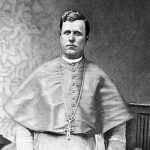
Father Lawrence McMahon, a native of New Brunswick and a distinguished Civil War chaplain, was named Hartford’s fifth bishop in 1879. During his episcopate of fourteen years, forty-eight parishes and sixteen parish schools were established. In 1882, a young diocesan priest, Father Michael McGivney, a native of Waterbury, organized in the basement of St. Mary Church in New Haven, a small group of Catholic men who would be known as the Knights of Columbus.
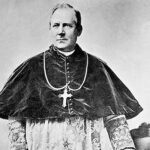
Father Michael Tierney, Chancellor and Rector of the the newly dedicated cathedral, succeeded Bishop McMahon as the sixth bishop of Hartford on February 22, 1894. Under Bishop Tierney’s leadership, a preparatory seminary of St. Thomas was founded on Collins Street in Hartford and dedicated on September 8, 1889. Another major accomplishment of Bishop Tierney was the establishment of five diocesan hospitals which continue to serve thousands throughout the State of Connecticut.
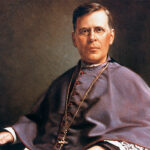
It could be said that by the time Father John J. Nilan was installed as Hartford’s seventh bishop on April 28, 1910, Catholicism in Connecticut had come of age. During his tenure, Bishop Nilan concerned himself with the fostering of many ethnic parishes which would serve Connecticut’s diverse population. In April of 1920, Father John Murray was consecrated first auxiliary bishop in Hartford. He was later named Ordinary of Portland, Maine and subsequently the Archbishop of St. Paul.

On April 25, 1934, Auxiliary Bishop Maurice F. McAuliffe, was appointed the eighth Bishop of Hartford. During his ten years as Bishop, the diocese added twenty-five parishes, primarily in the ever-growing suburbs. Bishop McAuliffe’s pastoral priority of educating all Catholics was demonstrated in his support of St. Joseph College, newly founded in West Hartford in 1932, and the founding of the Jesuit-run Fairfield College Preparatory School in 1942. During the war years, the diocese opened opportunities for the Catholic laity to become more involved in social ministry efforts such as Catholic Action, the Council of Catholic Women and the Confraternity of Christian Doctrine. Under Bishop McAuliffe’s leadership, parishioners joined more actively with clergy and religious in the mission of the Church in Connecticut.

The Most Reverend Henry J. O’Brien, Bishop McAuliffe’s auxiliary bishop who earlier served as rector of St. Thomas Seminary, was named ninth bishop of Hartford on April 7, 1945. During the prosperity of this post war era, the number of Connecticut Catholics was growing and many parishes were built in the suburbs. On August 6, 1953, Pope Pius XII established the dioceses of Bridgeport and Norwich and Hartford became an archdiocese, comprising Hartford, New Haven and Litchfield counties. As a result, on October 21, 1953, Bishop O’Brien was installed as the first Archbishop of Hartford. This time of great joy was followed three years later by a time of sadness when the Cathedral of St. Joseph was destroyed by fire on New Year’s Eve, 1956. Archbishop O’Brien immediately initiated plans for a new cathedral to be built on the same site. On May 15, 1962, Auxiliary Bishop John F. Hackett, consecrated the magnificent structure which continues to serve as the Cathedral Church of the Archdiocese of Hartford.
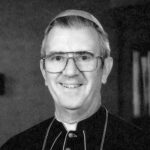
The Most Reverend John F. Whealon, Bishop of Erie, Pennsylvania and a native of Ohio, was installed as the second Archbishop of Hartford on March 19, 1969. Archbishop Whealon, a noted scripture scholar and ecumenist served this Archdiocese for twenty-two years. During his administration, the Church was blessed with a strong leader and able teacher who devoted time each week in teaching seminarians at Holy Apostles Seminary in Cromwell, as well as the permanent deacons of the Archdiocese.
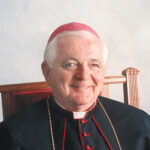
On January 28, 1992, the Most Reverend Daniel A. Cronin, Bishop of Fall River, was installed as the third Archbishop of Hartford. During his eleven years in Hartford, Archbishop Cronin continued to exhibit his strong leadership qualities as chief shepherd and teacher of our Archdiocese. Shortly after his arrival, Archbishop Cronin announced that he would reconvene the Archdiocesan Synod. Committees were established representing a broad spectrum of priests, religious and laity. Four sessions were held over a period of three months, culminating in the promulgation of a document entitled, “Recommendations of the Synod of 1996.”
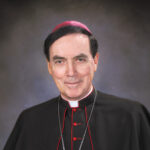
Upon the retirement of Archbishop Cronin in 2003, Bishop Henry J. Mansell of Buffalo, New York was named the fourth Archbishop of Hartford. Concern for the poor and marginalized and his strong support of Catholic Education became the hallmarks of ten years with us. Under the direction of Archbishop Mansell the former Cathedral Grade School located on Asylum Avenue in Hartford was renovated for affordable housing known as Cathedral Green. A new center for Hispanics was dedicated as Central San Jose and two hospital mobile units known as the Malta House of Care healthcare vans were put into service to provide necessary health services for those in need in the cities of Hartford and Waterbury. Plans for a third medical van in the New Haven region were begun under his leadership. For his untiring dedication to Catholic education, in 2014 Archbishop Mansell was awarded the prestigious St. Elizabeth Ann Seton Award by the National Catholic Educational Association at their annual dinner in Washington, D.C.
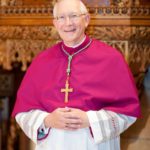
On October 29, 2013, Bishop Leonard P. Blair of Toledo, Ohio was named as the fifth Archbishop of Hartford and was installed on December 16, 2013. Archbishop Blair initiated a Pastoral Plan in 2016 to revitalize the archdiocese. A major part of the Pastoral Plan took effect on June 29, 2017 when the number of parishes was reduced from 213 to 127 by combining neighboring churches into a single parish. In 2018, Archbishop Blair called for an Archdiocesan Synod to further assess the spiritual and organizational vitality of the archdiocese and to set a path forward for a comprehensive effort of evangelization in light of Pope Francis’ calling the Church to be missionary disciples.
